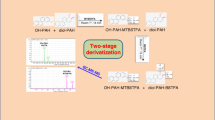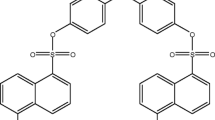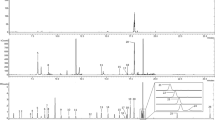Abstract
Parabens are preservatives widely used in personal care products, pharmaceutical formulations as well as in food, and they are considered endocrine disruptors. For application in biomonitoring studies we developed a method for the determination of eight parabens from human urine. Sample preparation was enhanced and simplified by the combination of ultrasound-assisted enzymatic hydrolysis of conjugates (glucuronide and sulfate) followed by an extraction-free cleanup step. Quantification, using deuterated parabens as internal standards, was performed by ultrahigh-performance liquid chromatography coupled to either triple-quadrupole (UPLC–QqQ) or time-of-flight (UPLC–QqTOF) mass spectrometry. Full chromatographic separation of three butyl paraben isomers was achieved. Limits of quantification for both mass analyzers ranged from 0.1 to 0.5 μg/L for methyl, ethyl, n-/isopropyl, n-/isobutyl, and benzyl paraben in 200 μL of urine sample. The method was tested for applicability and showed high precision (intra- and interday 0.9–14.5 %) as well as high accuracy (relative recovery 95–132 %). A total of 39 urine samples were analyzed by both mass analyzers. The results agreed well, with a trend to higher deviation at low concentrations (less than 10 μg/L). Methyl, ethyl, and n-propyl paraben were detected most frequently (in more than 87 % of the samples) with median concentrations ranging from 0.8 to 16.6 μg/L. Female urine showed higher median concentrations for all parabens, which may indicate higher exposure due to lifestyle. This method permits accurate and high-throughput analysis of parabens for epidemiological studies. Further, the UPLC–QqTOF approach provides additional information on human exposure to other compounds by post-acquisition analysis.

Analytical procedure for paraben analysis from human urine samples including ultrasound-enhanced enzymatic digestion of glucuronide and sulfate conjugates, extraction-free clean-up and quantification by UHPLC-MS/MS.





Similar content being viewed by others
References
Błedzka D, Gromadzińska J, Wasowicz W (2014) Parabens. From environmental studies to human health. Environ Int 67:27–42. doi:10.1016/j.envint.2014.02.007
Regulation (EC) No 1333/2008 of the European Parliament and of the Council of 16 December 2008 on food additives. OJ L 354, 31.12.2008, p 16
Commission Regulation No 1004/2014 of 18 September 2014 (amending Annex V to Regulation (EC) No 1223/2009) of the European Parliament and of the Council on cosmetic products. OJ L 282, 29.09.2014, p 5
Moos RK, Koch HM, Angerer J, Apel P, Schröter-Kermani C, Brüning T et al (2015) Parabens in 24 h urine samples of the German Environmental Specimen Bank from 1995 to 2012. Int J Hyg Environ Health 218(7):666–74. doi:10.1016/j.ijheh.2015.07.005
Frederiksen H, Nielsen JKS, Mørck TA, Hansen PW, Jensen JF, Nielsen O et al (2013) Urinary excretion of phthalate metabolites, phenols and parabens in rural and urban Danish mother–child pairs. Int J Hyg Environ Health 216(6):772–83. doi:10.1016/j.ijheh.2013.02.006
Ye X, Bishop AM, Reidy JA, Needham LL, Calafat AM (2006) Parabens as urinary biomarkers of exposure in humans. Environ Health Perspect 114(12):1843–6
Wang L, Wu Y, Zhang W, Kannan K (2013) Characteristic profiles of urinary p-hydroxybenzoic acid and its esters (parabens) in children and adults from the United States and China. Environ Sci Technol 47(4):2069–76. doi:10.1021/es304659r
Schlumpf M, Kypke K, Wittassek M, Angerer J, Mascher H, Mascher D et al (2010) Exposure patterns of UV filters, fragrances, parabens, phthalates, organochlor pesticides, PBDEs, and PCBs in human milk: correlation of UV filters with use of cosmetics. Chemosphere 81(10):1171–83. doi:10.1016/j.chemosphere.2010.09.079
Frederiksen H, Jorgensen N, Andersson A-M (2011) Parabens in urine, serum and seminal plasma from healthy Danish men determined by liquid chromatography-tandem mass spectrometry (LC-MS/MS). J Expo Sci Environ Epidemiol 21(3):262–71
Liao C, Liu F, Kannan K. Occurrence of and dietary exposure to parabens in foodstuffs from the United States. Environ Sci Technol 2013;47(8):3918–25. doi:10.1021/es400724s
Wang L, Liao C, Liu F, Wu Q, Guo Y, Moon H-B et al (2012) Occurrence and human exposure of p-hydroxybenzoic acid esters (parabens), bisphenol A diglycidyl ether (BADGE), and their hydrolysis products in indoor dust from the United States and three East Asian countries. Environ Sci Technol 46(21):11584–93. doi:10.1021/es303516u
Okubo T, Yokoyama Y, Kano K, Kano I (2001) ER-dependent estrogenic activity of parabens assessed by proliferation of human breast cancer MCF-7 cells and expression of ERα and PR. Food Chem Toxicol 39(12):1225–32. doi:10.1016/S0278-6915(01)00073-4
Darbre PD, Harvey PW (2008) Paraben esters: review of recent studies of endocrine toxicity, absorption, esterase and human exposure, and discussion of potential human health risks. J Appl Toxicol 28(5):561–78. doi:10.1002/jat.1358
Savage JH, Matsui EC, Wood RA, Keet CA (2012) Urinary levels of triclosan and parabens are associated with aeroallergen and food sensitization. J Allergy Clin Immunol 130(2):453–60
Schlittenbauer L, Seiwert B, Reemtsma T (2015) Matrix effects in human urine analysis using multi-targeted liquid chromatography-tandem mass spectrometry. J Chromatogr A 1415:91–9. doi:10.1016/j.chroma.2015.08.069
Blount BC, Milgram KE, Silva MJ, Malek NA, Reidy JA, Needham LL et al (2000) Quantitative detection of eight phthalate metabolites in human urine using HPLC−APCI-MS/MS. Anal Chem 72(17):4127–34. doi:10.1021/ac000422r
Ye X, Zhou X, Hennings R, Kramer J, Calafat AM (2013) Potential external contamination with bisphenol A and other ubiquitous organic environmental chemicals during biomonitoring analysis: an elusive laboratory challenge. Environ Health Perspect 121(3):283–6. doi:10.1289/ehp.1206093
Dewalque L, Pirard C, Dubois N, Charlier C (2014) Simultaneous determination of some phthalate metabolites, parabens and benzophenone-3 in urine by ultra high pressure liquid chromatography tandem mass spectrometry. J Chromatogr B 949–950:37–47. doi:10.1016/j.jchromb.2014.01.002
Alvarez-Sanchez B, Priego-Capote F, Luque de Castro MD (2009) Ultrasound-enhanced enzymatic hydrolysis of conjugated female steroids as pretreatment for their analysis by LC-MS/MS in urine. Analyst 134(7):1416–22. doi:10.1039/b816283b
EU (2014) Commission Regulation (EU) No 358/2014 of 9 April 2014 amending Annexes II and V to Regulation (EC) No 1223/2009 of the European Parliament and of the Council on cosmetic products. Off J Eur Union 107
Soni MG, Burdock GA, Taylor SL, Greenberg NA (2001) Safety assessment of propyl paraben: a review of the published literature. Food Chem Toxicol 39(6):513–32. doi:10.1016/S0278-6915(00)00162-9
Asimakopoulos AG, Wang L, Thomaidis NS, Kannan K (2014) A multi-class bioanalytical methodology for the determination of bisphenol A diglycidyl ethers, p-hydroxybenzoic acid esters, benzophenone-type ultraviolet filters, triclosan, and triclocarban in human urine by liquid chromatography-tandem mass spectrometry. J Chromatogr A 1324:141–8. doi:10.1016/j.chroma.2013.11.031
Lee S-Y, Son E, Kang J-Y, Lee H-S, Shin M-K, Nam H-S et al (2013) Development of a quantitative analytical method for determining the concentration of human urinary paraben by LC-MS/MS. Bull Kor Chem Soc 34(4):1131–6. doi:10.5012/bkcs.2013.34.4.1131
Shirai S, Suzuki Y, Yoshinaga J, Shiraishi H, Mizumoto Y (2013) Urinary excretion of parabens in pregnant Japanese women. Reprod Toxicol 35:96–101. doi:10.1016/j.reprotox.2012.07.004
Larsson K, Ljung Björklund K, Palm B, Wennberg M, Kaj L, Lindh CH et al (2014) Exposure determinants of phthalates, parabens, bisphenol A and triclosan in Swedish mothers and their children. Environ Int 73:323–33. doi:10.1016/j.envint.2014.08.014
Gavin QW, Ramage RT, Waldman JM, She J (2013) Development of HPLC-MS/MS method for the simultaneous determination of environmental phenols in human urine. Int J Environ Anal Chem 94(2):168–82. doi:10.1080/03067319.2013.814123
Moos RK, Angerer J, Wittsiepe J, Wilhelm M, Brüning T, Koch HM (2014) Rapid determination of nine parabens and seven other environmental phenols in urine samples of German children and adults. Int J Hyg Environ Health 217(8):845–53. doi:10.1016/j.ijheh.2014.06.003
Ye X, Kuklenyik Z, Bishop AM, Needham LL, Calafat AM (2006) Quantification of the urinary concentrations of parabens in humans by on-line solid phase extraction-high performance liquid chromatography-isotope dilution tandem mass spectrometry. J Chromatogr B 844(1):53–9. doi:10.1016/j.jchromb.2006.06.037
Myridakis A, Balaska E, Gkaitatzi C, Kouvarakis A, Stephanou E (2015) Determination and separation of bisphenol A, phthalate metabolites and structural isomers of parabens in human urine with conventional high-pressure liquid chromatography combined with electrospray ionisation tandem mass spectrometry. Anal Bioanal Chem 407:2509–18. doi:10.1007/s00216-015-8497-5
Haman C, Dauchy X, Rosin C, Munoz J-F (2015) Occurrence, fate and behavior of parabens in aquatic environments: a review. Water Res 68:1–11. doi:10.1016/j.watres.2014.09.030
Jiménez-Díaz I, Zafra-Gómez A, Ballesteros O, Navalón A (2014) Analytical methods for the determination of personal care products in human samples: an overview. Talanta 129:448–58. doi:10.1016/j.talanta.2014.05.052
Wang H-x, Wang B, Zhou Y, Jiang Q-W (2013) Rapid and sensitive analysis of phthalate metabolites, bisphenol A, and endogenous steroid hormones in human urine by mixed-mode solid-phase extraction, dansylation, and ultra-performance liquid chromatography coupled with triple quadrupole mass spectrometry. Anal Bioanal Chem 405(12):4313–9. doi:10.1007/s00216-013-6779-3
Setchell KD (1998) Phytoestrogens: the biochemistry, physiology, and implications for human health of soy isoflavones. Am J Clin Nutr 68(6):1333S–46
Ma W-L, Wang L, Guo Y, Liu L-Y, Qi H, Zhu N-Z et al (2013) Urinary concentrations of parabens in Chinese young adults: implications for human exposure. Arch Environ Contam Toxicol 65(3):611–8. doi:10.1007/s00244-013-9924-2
Calafat AM, Ye X, Wong L-Y, Bishop AM (2010) Urinary concentrations of four parabens in the US population: NHANES 2005–2006. Environ Health Perspect 118(5):679–85. doi:10.1289/ehp.0901560
Goen T, Dobler L, Koschorreck J, Muller J, Wiesmuller GA, Drexler H et al (2011) Trends of the internal phthalate exposure of young adults in Germany—follow-up of a retrospective human biomonitoring study. Int J Hyg Environ Health 215(1):36–45. doi:10.1016/j.ijheh.2011.07.011
Asimakopoulos AG, Thomaidis NS, Kannan K (2014) Widespread occurrence of bisphenol A diglycidyl ethers, p-hydroxybenzoic acid esters (parabens), benzophenone type-UV filters, triclosan, and triclocarban in human urine from Athens, Greece. Sci Total Environ 470–471:1243–9. doi:10.1016/j.scitotenv.2013.10.089
Reemtsma T, Lingott J, Roegler S (2011) Determination of 14 monoalkyl phosphates, dialkyl phosphates and dialkyl thiophosphates by LC-MS/MS in human urinary samples. Sci Total Environ 409(10):1990–3. doi:10.1016/j.scitotenv.2011.01.032
Jekel M, Ruhl AS, Meinel F, Zietzschmann F, Pflugmacher Lima S, Baur N et al (2013) Anthropogenic organic micro-pollutants and pathogens in the urban water cycle: assessment, barriers and risk communication (ASKURIS). Environ Sci Eur 25(1):20. doi:10.1186/2190-4715-25-20
Acknowledgments
This work is part of the ASKURIS project (contract 02WRS1278A) and supported by the Federal Ministry of Education and Research (BMBF) within the funding measure RiSKWa [39]. We would like to thank Caroline Davis for supporting the optimization and method applicability experiments. We are grateful to one of the reviewers for his careful revision.
Author information
Authors and Affiliations
Corresponding author
Ethics declarations
Conflict of interest
The authors declare that there is no conflict of interest.
Informed consent
All volunteers were informed about the purpose of sampling and provided their consent. All samples were received anonymously and no personal information of the individuals that provided samples was collected at any stage of the study.
Electronic supplementary material
Below is the link to the electronic supplementary material.
ESM 1
(PDF 98 kb)
Rights and permissions
About this article
Cite this article
Schlittenbauer, L., Seiwert, B. & Reemtsma, T. Ultrasound-assisted hydrolysis of conjugated parabens in human urine and their determination by UPLC–MS/MS and UPLC–HRMS. Anal Bioanal Chem 408, 1573–1583 (2016). https://doi.org/10.1007/s00216-015-9265-2
Received:
Revised:
Accepted:
Published:
Issue Date:
DOI: https://doi.org/10.1007/s00216-015-9265-2




